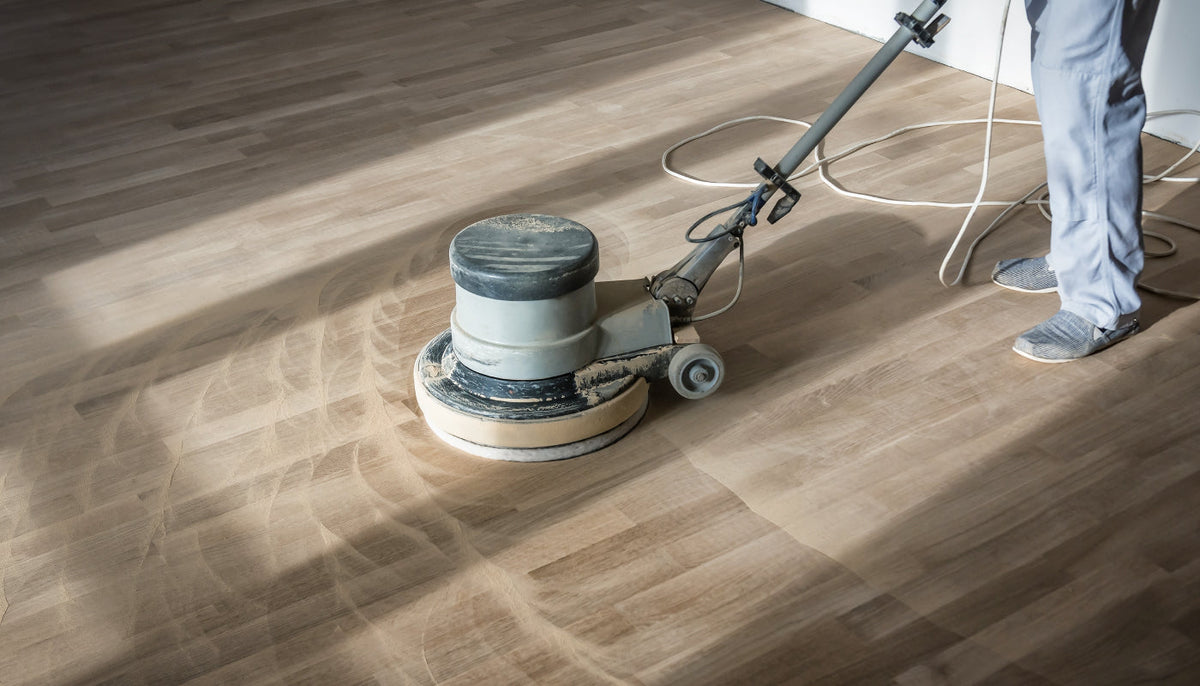
Different Types of Floor Sanders and Their Uses
|
|
Time to read 4 min
|
|
Time to read 4 min
Refinishing worn hardwood floors isn’t a DIY project for the squeamish, but if you’re determined and somewhat skilled, you can pull it off with the right equipment and materials. Sanding a hardwood floor is the first step of the refinishing process. Here, we look at the different types of floor sanders and offer some tips for getting the best possible results.
There are several different types of sanders used for refinishing hardwood floors. All are available to rent at your local tool rental center, where you can also purchase sandpaper to fit each machine.
Drum sanders are massively heavy beasts that generally require two people to carry. A large sandpaper belt fits over a rotating drum, which spins at high velocity and makes quick work of sanding a floor. A built-in dust bag catches most of the dust and debris, although you’ll need to vacuum thoroughly before coating the floor.
Drum sanders are powerful enough to remove finishes and stains, smooth high spots, and take the floor down to a layer of bare, untouched wood. If you’re not experienced with this type of machine, you can quickly cause serious, permanent damage to your floor if you aren’t very careful. If the sander isn’t positioned just right and properly operated, it can grind deep grooves and valleys into the wood.
An orbital sander consists of a circular or square sanding pad that moves in a small orbital pattern. Orbital sanders are primarily used for finishing, because they remove little material. Although sanding a floor with an orbital sander will take considerably longer than it would with a drum sander, and it’ll require more sandpaper, an orbital sander is less likely to cause permanent damage to your floor. A square orbital sander can reach into corners and other spaces that a large drum sander can’t reach.
Like orbital sanders, vibrating sanders are used primarily as a finishing sander to smooth out the wood after using the drum sander. A vibrating sander is about the same size as a drum sander, and it also has a dust bag attached. However, it’s much lighter, and rather than a rotating belt, it consists of a vibrating sanding pad. This makes it much easier to move across the floor in smooth passes. Like orbital sanders, vibrating sanders are less likely than drum sanders to damage the floor.
Drum sanders, vibrating sanders, and some large orbital sanders are too big and bulky to reach into corners and along the edges of the room where the floor meets the wall. Enter the edge sander, which is a heavy, hand-held sander with an orbital sanding pad and a built-in dust bag. Because of its weight, an edge sander is as effective as a drum sander at removing surface material, but it can damage the floor if it’s improperly used, causing gouges and circular marks in the wood.
Sanding a floor involves multiple passes over every inch of the surface. With each subsequent sanding, the sandpaper grit gets finer. Most floors require about four passes. The more damaged the floor, or the harder the wood, the courser the starting sandpaper grit should be. Here are a few tips to help ensure the best sanding job possible.
If you’re refinishing the floors in multiple rooms, sand them all at the same time. For each pass, first use the drum sander, and then use the edger.
After each pass, vacuum the floors, even if there’s a bag attached to the sander. This will ensure pieces of sanding grit that fall off the sander don’t damage the floor on subsequent, smaller-grit passes.
No matter how experienced you are with the edging sander, there’s a high likelihood that there will be “edger swirl” around the perimeter of the room. Remove this by sanding the swirl by hand with 80-grit sandpaper. Using an orbital or vibrating sander to remove the swirl will over-polish the edges, giving them a different texture than the rest of the floor.
Even the tiniest speck of dust can show up permanently on your floor once the coating is laid down. A thorough vacuuming is crucial for a perfect finish. Vacuum at least twice, paying special attention to the cracks between the planks and along the baseboards. After vacuuming, use a dry microfiber cloth to remove the finest specks from the floor.
Sanding can be dangerous if you don’t take proper safety precautions. Always wear goggles to prevent serious eye damage due to flying debris, and wear a dust mask to protect your lungs from fine airborne particles. Long sleeves, pants, and gloves will prevent your skin from being coated with tiny particles. Finally, keep all cords well out of your way as you’re moving across the floor.
While refinishing hardwood floors isn’t particularly difficult, it’s an extremely involved and taxing job, requiring specialized, heavy equipment and the right sandpaper grits and coating products. Small, common mistakes by DIYers can have a big impact on the floor’s appearance once it’s coated.
If you want a perfect refinishing job, it’s probably best to call in a pro. Reputable professional flooring contractors have top-of-the-line equipment and the skills and expertise necessary to address a wide range of floor issues. As always, do your due diligence before selecting a contractor.
If you choose to go the DIY route, more power to you! Educate yourself about the tools you’ll need, including different types of sanders and applicators, and how to use them. Use high quality finishing products, and keep your safety in mind at every step. The more you know going in, the better your refinished floor will look.